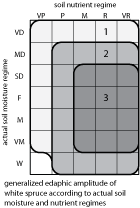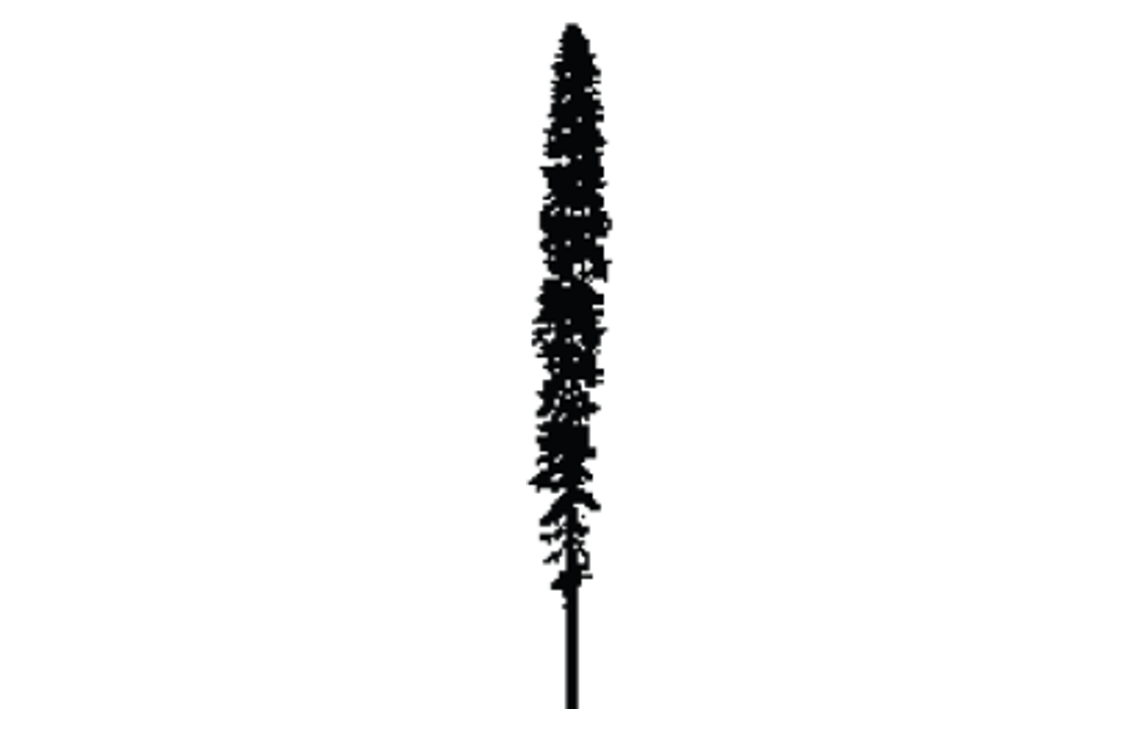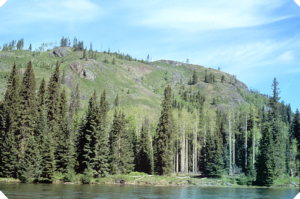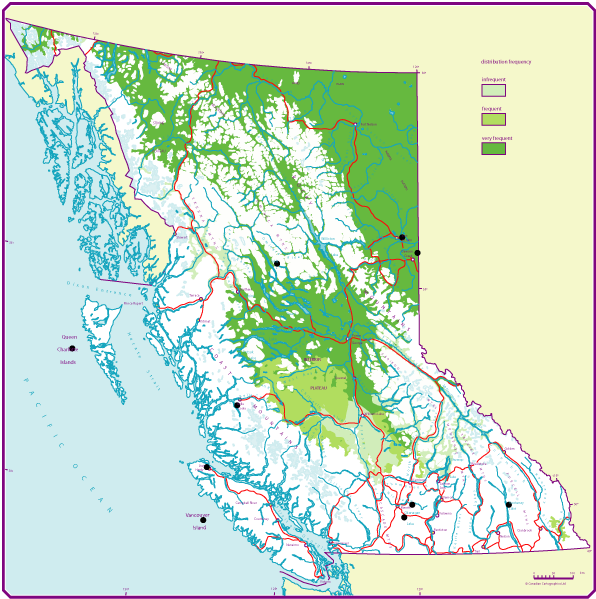White spruce
On this page
- Geographic range and ecological amplitudes
- Tolerances and damaging agents
- Silvical characteristics
- Genetics and notes
Geographic range and ecological amplitudes
Description
White spruce is a medium-sized (occasionally >55m tall), evergreen conifer, with a fairly symmetrical, conical crown, a regular branching pattern that often extends to the ground, and a smooth, dark gray, scaly bark. The wood of white spruce is light, straight grained, and resilient. It is used primarily for lumber and pulp.
Geographic range
Geographic element:
North American transcontinental-incomplete
Distribution in Western North America:
(north) in the Pacific region; north and central in the Cordilleran region
Ecological amplitudes
Climatic amplitude:
subarctic – subalpine boreal – montane boreal – (cool temperate)
Orographic amplitude:
montane – subalpine
Occurrence in biogeoclimatic zones:
SWB, (ESSF), MS, BWBS, SBS, SBPS, (IDF), (ICH), (northern CWH)
Edaphic amplitude

Range of soil moisture regimes:
(very dry) – moderately dry – slightly dry – fresh – moist – very moist – wet
Range of soil nutrient regimes:
(very poor) – poor – medium – rich – very rich
In the BWBS zone, white spruce grows well on medium and rich sites providing a Moder humus formation exists. Wildfires are the major disturbance factor in re-establishing a white spruce stand when acidic Mors begin to develop, a humus form which favors the regeneration and growth of black spruce. Without the fires, the more shade-tolerant black spruce would become a dominant species and form a climatic climax stand. Thus, forest fires provide opportunities for the less shade-tolerant white spruce to become re-established. The same result is obtained by clearcutting, which promotes faster decomposition of organic materials and, hence, the Moder humus formation which favors the establishment and growth of white spruce.
Tolerance and damaging agents
Root system characteristics
White spruce is usually characterized as shallow rooted; however, depth of rooting in low-latitude soils without a root-restricting layer can be 120cm, with taproots and sinker roots possibly descending to a depth of 300cm. Roots of white spruce are associated with both ecto- and endo-mycorrhizae.
| Tolerance to | Tolerance class | Comments |
|---|---|---|
| Low light | M | Less tolerant than subalpine fir; approximately as tolerant as Engelmann spruce. |
| Frost | H | Withstands severe winter temperature; only moderately tolerant to growing-season frost. |
| Heat | M | occasionally grows on insolated sites |
| Water deficit | M | Infrequent on very dry sites. |
| Water surplus | H | Frequent on waterlogged sites; less tolerant of prolonged flooding. |
| Nutrient (mainly N) deficiency | M | Absent or infrequent on very poor sites. |
| Damaging agent | Resistance class | Comments |
|---|---|---|
| Snow | M | Increasing with increasing age |
| Wind | L | Very low resistance when exposed and in partially cut stands. |
| Risk class | ||
|---|---|---|
| Fire | H | Especially in dry boreal climates. |
| Insect | M to H | High in old-growth stands: spruce beetle; western spruce budworm; white pine weevil. |
| Fungi | M | Root and butt rots (Armillaria root disease, tomentosus root rot, and red ring rot). |
Associated tree species and successional role
In British Columbia, white spruce grows infrequently in pure stands. It is present in early, mid-, and late stages of secondary succession. It is a minor component in old growth stands in the IDF, ICH, and northern CWH zones; a variable component in old-growth stands in the SWB, BWBS, SBS, and SBPS zones.
| Associated tree species |
Occurance class | Major area of occurance |
|---|---|---|
| Trembling aspen | H | Throughout montane boreal climates in central and northern B.C. |
| Lodgepole pine | H | Throughout montane boreal climates in central and northern B.C. |
| Black spruce | H | BWBS. |
| Subalpine fir | H | The most commonly associated species. |
| Balsam poplar and Black cottonwood | M | High floodplain benches. |
| Paper birch | M | Mainly in BWBS and SBS. |
| Common douglas | L | Mainly in MS, SBS, northern IDF, and ICH. |
| Western hemlock | L | Northern and central ICH. |
| Sitka spruce | L | extreme northern portion of CWH in southeastern Alaska |
| Engelmann spruce | L | Mainly in the upper MS, SBS, and ICH. |
| Tamarack | L | BWBS. |
Genetics and notes
Genetics
White spruce is highly variable over its range. White and Engelmann spruces and Sitka and Engelmann spruces are sympatric over large areas in British Columbia and hybridize, while hybridization is rare between white and black spruces. However, a hybrid of this type was found in Minnesota and was discussed by Little and Pauley (1958) under the English name Rosendahl spruce. Such a hybrid, evidently more similar to white spruce than to black spruce, has been also occasionally observed in the BWBS zone as well as in the SBS zone. Also, another nothomorph was collected from the Atlin area and described as P. x glaucana by Krajina. This hybrid is intermediate between the two species.
Hybrids between white and Engelmann spruce are very common and cannot be easily distinguished from the parent species. They are commonly referred to as hybrid white spruce or interior spruce (Sx) (Picea engelmannii x glauca); hybrids between Sitka and Engelmann spruce are often referred to as Roche spruce (see Picea engelmannii).
Notes
White spruce is a desirable component in pure or mixed-species stands in montane boreal forests, mixed with other either softwoods or hardwoods. The success of natural regeneration is often inconsistent; consequently planting is usually required if a high component of white spruce is desired in new stands. More detailed silvics information is given by:
Coates, K.D., S. Haeussler, S. Lindeburgh, R. Pojar, and A.J. Stock. 1994. Ecology and silviculture of interior spruce in British Columbia. FRDA Report 220, B.C. Min. For., Victoria, B.C. 182 pp.
Nienstaedt, H. and J.C. Zasada. 1990. Picea glauca. Pp. 204-226 in R.M. Burns and B.H. Honkala (technical coordinators) Silvics of North America, Vol. 1. Agri. Handbook 654, USDA For. Serv., Washington, D.C.

This is the general shape and outline of the white spruce.

An open canopy stand of white spruce and trembling aspen on Morice River alluvial terrace. Pure white spruce stands are infrequent in the fire-disturbed, montane boreal landscape.

